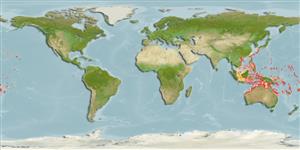Teleostei (teleosts) >
Ovalentaria/misc (Various families in series Ovalentaria) >
Pomacentridae (Damselfishes) > Pomacentrinae
Etymology: Pomacentrus: Greek, poma, -atos = cover, operculum + Greek, kentron = sting (Ref. 45335).
More on authors: Jordan & Seale.
Environment: milieu / climate zone / depth range / distribution range
Ecology
Marine; reef-associated; non-migratory; depth range 0 - 45 m (Ref. 7247). Tropical; 35°N - 25°S, 104°E - 159°W
Pacific Ocean: Moluccas to Samoa, north to the Izu Islands, south to Rowley Shoals in the eastern Indian Ocean and New Caledonia.
Size / Weight / Age
Maturity: Lm ? range ? - ? cm
Max length : 10.0 cm FL male/unsexed; (Ref. 5525)
Comprises several color forms, or geographical variations (Ref. 48636). Adults are found in mixed coral and rubble areas of lagoon and seaward reefs from the lower surge zone to a depth of 40 m (Ref. 1602). Solitary (Ref. 37816). Feed on filamentous algae and small invertebrates (Ref. 1602). Oviparous, distinct pairing during breeding (Ref. 205). Eggs are demersal and adhere to the substrate (Ref. 205). Males guard and aerate the eggs (Ref. 205). Diurnal species (Ref. 54980; 113699). Minimum depth reported taken from Ref. 128797.
Life cycle and mating behavior
Maturities | Reproduction | Spawnings | Egg(s) | Fecundities | Larvae
Oviparous, distinct pairing during breeding (Ref. 205). Eggs are demersal and adhere to the substrate (Ref. 205). Males guard and aerate the eggs (Ref. 205).
Allen, G.R., 1991. Damselfishes of the world. Mergus Publishers, Melle, Germany. 271 p. (Ref. 7247)
IUCN Red List Status (Ref. 130435)
Threat to humans
Harmless
Human uses
Fisheries: commercial; aquarium: commercial
Tools
Special reports
Download XML
Internet sources
Estimates based on models
Preferred temperature (Ref.
123201): 25.4 - 28.9, mean 27.7 °C (based on 332 cells).
Phylogenetic diversity index (Ref.
82804): PD
50 = 0.5000 [Uniqueness, from 0.5 = low to 2.0 = high].
Bayesian length-weight: a=0.02630 (0.01675 - 0.04130), b=2.91 (2.78 - 3.04), in cm total length, based on LWR estimates for this species & Genus-body shape (Ref.
93245).
Trophic level (Ref.
69278): 3.1 ±0.33 se; based on food items.
Resilience (Ref.
120179): High, minimum population doubling time less than 15 months (Preliminary K or Fecundity.).
Fishing Vulnerability (Ref.
59153): Low vulnerability (10 of 100).
Nutrients (Ref.
124155): Calcium = 113 [55, 181] mg/100g; Iron = 0.852 [0.501, 1.436] mg/100g; Protein = 18.1 [16.9, 19.3] %; Omega3 = 0.124 [0.070, 0.211] g/100g; Selenium = 24.6 [12.2, 49.8] μg/100g; VitaminA = 152 [44, 532] μg/100g; Zinc = 1.56 [1.02, 2.27] mg/100g (wet weight);
